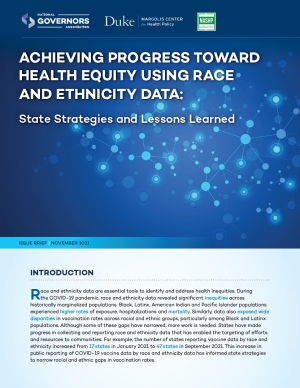
Policy Brief
Achieving Progress Toward Health Equity Using Race and Ethnicity Data: State Strategies and Lessons Learned
Race and ethnicity data are essential tools to identify and address health inequities. During the COVID-19 pandemic, race and ethnicity data revealed significant inequities across historically marginalized populations. Black, Latinx, American Indian and Pacific Islander populations experienced higher rates of exposure, hospitalizations and mortality. Similarly, data also exposed wide disparities in vaccination rates across racial and ethnic groups, particularly among Black and Latinx populations. Although some of these gaps have narrowed, more work is needed. States have made progress in collecting and reporting race and ethnicity data that has enabled the targeting of efforts and resources to communities. For example, the number of states reporting vaccine data by race and ethnicity increased from 17 states in January 2021 to 47 states in September 2021. This increase in public reporting of COVID-19 vaccine data by race and ethnicity data has informed state strategies to narrow racial and ethnic gaps in vaccination rates.
States have employed different strategies to collect and report race and ethnicity data during the pandemic. While the number of states reporting race and ethnicity data for vaccinations has increased, there remain gaps in the completeness and accuracy of these data. According to the Centers for Disease Control and Prevention’s COVID Data Tracker, race and ethnicity is missing for about 29 percent of fully vaccinated people across the United States. The CDC notes that missing data may result from inconsistencies in collecting race and ethnicity data at the time of vaccination, differences in electronic data programs across jurisdictions, and variations in policies or laws limiting reporting or sharing of demographic data. Similar challenges exist for cases and mortality data. Such missing data complicate the collective understanding of COVID-19’s impact among historically marginalized populations and limit efforts to improve health equity. With an increasing number of states committed to improving health equity and the availability of various funding streams—including funds from the American Rescue Plan Act—states can further achieve progress toward health equity by adopting promising strategies and incorporating lessons learned during the COVID-19 pandemic.
In June 2021, the National Governors Association Center for Best Practices, the Duke-Margolis Center for Health Policy, and the National Academy for State Health Policy co-hosted a virtual summit on data and health equity. The summit convened state leaders from 20 states to discuss challenges and strategies for collecting, reporting and using race and ethnicity data to improve health equity during and beyond the COVID-19 pandemic. This issue brief summarizes state strategies and experiences shared during the convening, as well as lessons learned during the COVID-19 pandemic.
Duke-Margolis Affiliated Authors

Jeremy Jacobs
2020 Margolis Intern
2021 Margolis Intern

Andrea Thoumi, MPP, MSc
Area Lead, Community Health and Equity
Faculty Director of Health Equity Educational Programming
Senior Team Member
Anti-Racism and Equity Committee Member
Core Faculty Member
Adjunct Assistant Professor
2020 Intern Mentor
